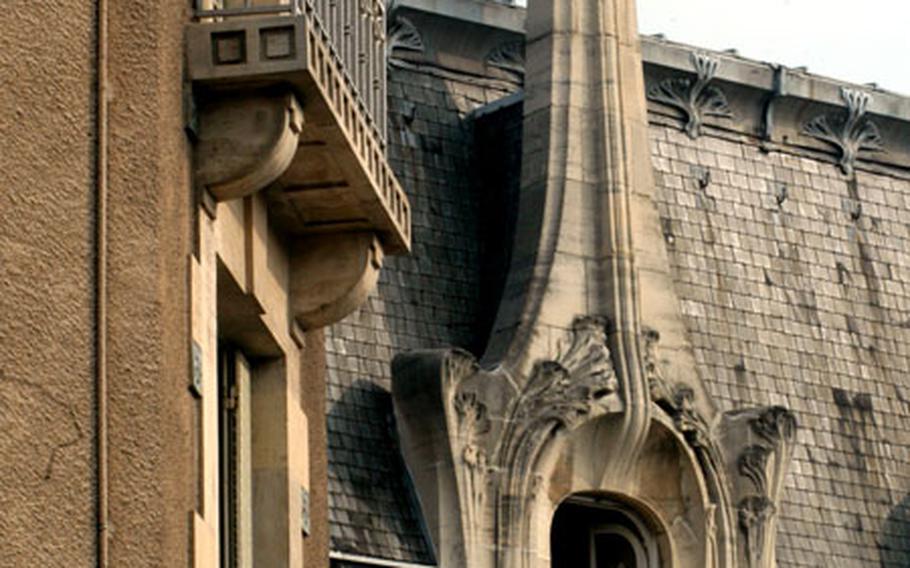
The Maison Weissenburger is one of Nancy’s better-known art nouveau buildings. (Peter Jaeger / S&S)
Nancy, France, is a city known for its art, architecture and city design. It is a place everyone should go see.
Just don’t do it now.
The city’s grandest attraction, Place Stanislas, is undergoing renovation. The “metamorphosis” is in preparation for this year’s 250th anniversary of its creation and is scheduled to be completed in April — although a clerk at the nearby tourist office told us it would be ready in May.
The Place was designed to honor French King Louis XV by his father-in-law, Stanislas Lesczynski. Stanislas had been king of Poland briefly, and a French-backed effort to restore him to power failed. However, he was made duke of Lorraine by the French king, and from a position of comfort promoted the arts, sciences and the good life.
Place Stanislas forms a rectangle, about the size of three football fields lying side by side. It is open in the middle except for a statue of Stanislas — the original statue of Louis XV was destroyed during the French Revolution and replaced by the one of Stanislas in 1831.
The Place is surrounded by matching buildings, including the town hall. At its corners are gates with elaborate grill work, parts of them painted gold. It has two fountains, the larger one completely covered as part of the renovation.
The Place is getting new drainage and paving stones and will be blocked off to traffic. Currently, it is possible only to walk along its borders. However the restaurants, museums, shops and hotel housed in its 250-year-old buildings are open for business.
Outside one gate is Parc de la Pepinere, a large park with walking paths, cafes and a small zoo. Outside another is Nancy’s own Arc de Triomphe and the old town, including the Ducal Palace. The palace houses the Musée Historique Lorraine, with exhibits about the history of the area, including one on Stanislas that is running through March 21.
About 150 years after the creation of Place Stanislas, Nancy again was an important center in design. Artists there developed art nouveau — a style of design that spread through Europe under different names, including Jugenstil in Germany. It mimicked nature with long, graceful lines, often in the shape of plant vines and tendrils, and was used in making glassware, jewelry, furniture, textile and posters.
For a brief period, architects used the same look to create buildings. No longer were they rigid blocks with rectangular doors and windows, but rather structures with rounded arches, circular windows, balconies with railings that resembled plant stems and leaves, and turrets rising from the roofs and sides of buildings. Doors and windows often included patterns with colored glass, and inside there were drop ceilings with glass designs illuminated from above by lights.
Several of these buildings are clustered along a pedestrian shopping area that runs from a few blocks from Place Stanislas down to the train station and beyond. One of the buildings is the Brasserie Excelsior, just across from the train station and a popular place for people to stop for a drink and to admire the scenery.
Nancy is still considered one of the centers for art nouveau architecture — along with the larger cities of Paris; Brussels, Belgium; and Vienna, Austria. The tourist office has a map listing 67 buildings that can be viewed from the outside. You can step inside some of them for a quick look around, assuming you remember they are still a place of business and don’t make a fuss.
On the QT…
DIRECTIONS: Take Autobahn 6 from the Kaiserslautern area to the French border, where it becomes Autoroute 4. Continue toward Paris, to the intersection with Autoroute 31 just past Metz. Head south until the exits for the center of Nancy, and follow signs for either Office de Tourisme or Place Stanislas. The drive takes about two hours from Kaiserslautern, and there is one toll, for 3.70 euros.
TIMES: It is possible to go any time to see Place Stanislas and the art nouveau buildings, but the viewing of both would be better in good weather — say, after early May when the renovation work should be done. The Musée Historique Lorraine is closed on Tuesday, and the Musée de l’Ecole de Nancy, is closed Mondays and Tuesdays.
COSTS: Admission to the Musée Historique Lorraine and the neighboring church is 3.10 euros for adults, 2.30 for children; the price for both the special Stanislas exhibit and museum is 6 euros, with the ticket good all day (the museum closes for 90 minutes at 12:30 p.m.) Admission to the Musée de l’Ecole de Nancy is 4.60 for adults, 2.30 for children.
FOOD: There are places to eat around Place Stanislas, the museums and the pedestrian shopping areas, including restaurants, cafes and carry-out sandwich shops. The Brasserie Excelsior serves meals, but they aren’t cheap so you may be better off settling for a cup of coffee there.
INFORMATION: The tourist office at Place Stanislas is open 9 a.m. to 7 p.m. Monday through Saturday and 10 a.m. to 5 p.m. on Sundays and holidays from April to October, and 9 a.m. to 6 p.m. Monday through Saturday and 10 a.m. to 1 p.m. Sundays and holidays the rest of the year. Its Web site is www.ot-nancy.fr. For a list of activities, see www.nancy2005.com.
— John Taylor